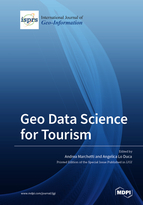Geo Data Science for Tourism
A special issue of ISPRS International Journal of Geo-Information (ISSN 2220-9964).
Deadline for manuscript submissions: closed (31 August 2021) | Viewed by 23598
Special Issue Editors
Interests: open data; data visualization; data science; web applications; cartographic mapping techniques
Special Issues, Collections and Topics in MDPI journals
Interests: data science; data narrative; web applications; machine learning; cultural heritage; tourism
Special Issues, Collections and Topics in MDPI journals
Special Issue Information
Dear Colleagues,
The hospitality and tourism industries are considered as critical parts of the economy of a Country. Thanks to the availability of a huge quantity of geographical data, such industries can offer high-quality Web applications, which improve the attractiveness of tourism destinations as well as all the businesses related to tourism. In addition, the use of Web applications for tourism helps to understand tourists behavior, by managing, analyzing and visualizing huge quantities of geographical data, such as those contained in reviews about accommodations. However, Web applications applied to the tourism domain present several issues and challenges, such as their durability and copyright related to collected data. The use of open data for tourism (e.g. accommodations, restaurants, attractions, events, transportations) and open source maps to represent geographical data can be an answer to all these challenges.
This Special Issue calls for research articles related to novel approaches to geographical data collection, analysis and visualization related to the design and implementation of Web applications in the tourism domain. Original contributions that report on real experiences and use cases in the usage of any kind of geo data in the tourism domain are also encouraged.
While not excluding the possibility of presenting works on other topics regarding tourism, the specific topics of interest of this Special Issue are the following:
- Issues, challenges and solutions related to geographical data in the tourism domain
- Data Collection, Cleaning, Enrichment, Integration and Visualization of tourism geographical datasets
- Copyright issues related to the publication and use of collected geographical datasets of tourism entities
- Data Matching techniques for tourism entities based on geographical information (address, coordinates, geographical areas) for integrating two or more datasets
- Text Analysis of tourism entities reviews based on customer nationality
- Time Series analysis and forecasting related to tourism data of different geographical areas
- Machine Learning and Deep Learning Analysis of geographical datasets related to the tourism domain
- Web applications for tourism based on geographical maps
- Comparison among different open map services for tourism
- Analysis and Impact of the COVID-19 pandemic on tourism
Dr. Andrea Marchetti
Dr. Angelica Lo Duca
Guest Editors
Manuscript Submission Information
Manuscripts should be submitted online at www.mdpi.com by registering and logging in to this website. Once you are registered, click here to go to the submission form. Manuscripts can be submitted until the deadline. All submissions that pass pre-check are peer-reviewed. Accepted papers will be published continuously in the journal (as soon as accepted) and will be listed together on the special issue website. Research articles, review articles as well as short communications are invited. For planned papers, a title and short abstract (about 100 words) can be sent to the Editorial Office for announcement on this website.
Submitted manuscripts should not have been published previously, nor be under consideration for publication elsewhere (except conference proceedings papers). All manuscripts are thoroughly refereed through a single-blind peer-review process. A guide for authors and other relevant information for submission of manuscripts is available on the Instructions for Authors page. ISPRS International Journal of Geo-Information is an international peer-reviewed open access monthly journal published by MDPI.
Please visit the Instructions for Authors page before submitting a manuscript. The Article Processing Charge (APC) for publication in this open access journal is 1700 CHF (Swiss Francs). Submitted papers should be well formatted and use good English. Authors may use MDPI's English editing service prior to publication or during author revisions.
Keywords
- Tourism
- Geographical Data
- Data Science
- Data Collection
- Data Analysis
- Data Visualization
- Web Applications
- Open Data
- Open Map Services







